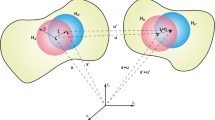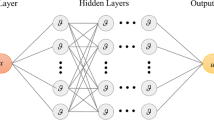Abstract
In existing works, the deep energy method (DEM) is developed based on deep neural networks to handle partial differential equation problems of finite deformation hyperelasticity. Inspired by the DEM, we propose a shallow energy method (SEM) which utilizes simple and efficient radial basis function neural networks (RBFNNs) with only one hidden layer as the approximator of the continuous displacement fields of the investigated structures. In our method, the energy items, including the internal energy and the external energy, are calculated through numerical integration techniques and form the overall potential energy functional with respect to the parameters of the RBFNNs. Then, the minimization problem of the potential energy is carried out by the L-BFGS algorithm embedded in Python optimizer packages. Finally, the numerical approximation of the true displacement field is yielded and compared to those obtained by the DEM and the FEM, to illustrate the validity, the accuracy and other good performance of the proposed SEM in dealing with problems of finite deformation hyperelasticity.




















Similar content being viewed by others
References
Weiss, J.A., Maker, B.N., Govindjee, S.: Finite element implementation of incompressible, transversely isotropic hyperelasticity. Comput. Methods Appl. Mech. Eng. 135(1), 107–128 (1996)
Chen, J.-S., Pan, C.: A pressure projection method for nearly incompressible rubber hyperelasticity, part I: theory. J. Appl. Mech. Trans. 63(4), 862–868 (1996). https://doi.org/10.1115/1.2787240
Schröder, J., Neff, P., Balzani, D.: A variational approach for materially stable anisotropic hyperelasticity. Int. J. Solids Struct. 42, 4352–4371 (2005)
Fachinotti, V., Cardona, A., Jetteur, P.: Finite element modelling of inverse design problems in large deformation anisotropic hyperelasticity. Int. J. Numer. Methods Eng. 74, 894–910 (2008). https://doi.org/10.1002/nme.2193
Silber, G., Alizadeh, M., Salimi, M.: Large deformation analysis for soft foams based on hyperelasticity. J. Mech. 26, 327–334 (2010). https://doi.org/10.1017/S1727719100003889
Duddu, R., Lavier, L., Hughes, T., Calo, V.: A finite strain Eulerian formulation for compressible and nearly incompressible hyperelasticity using high-order b-spline finite elements. Int. J. Numer. Methods Eng. 89, 762–785 (2012). https://doi.org/10.1002/nme.3262
Hu, D., Sun, Z., Liang, C., Han, X.: A mesh-free algorithm for dynamic impact analysis of hyperelasticity. Acta Mech. Solida Sin. 26, 362–372 (2013). https://doi.org/10.1016/S0894-9166(13)60033-6
Le Pense, S.: Mean stress dependent nonlinear hyperelasticity coupled with damage stiffness degradation. A thermodynamical approach. Mech. Res. Commun. 60, 85–89 (2014). https://doi.org/10.1016/j.mechrescom.2014.06.007
Zdunek, A., Rachowicz, W., Eriksson, T.: A five-field finite element formulation for nearly inextensible and nearly incompressible finite hyperelasticity. Comput. Math. Appl. (2016). https://doi.org/10.1016/j.camwa.2016.04.022
Hornik, K., Stinchcombe, M., White, H.: Multilayer feedforward networks are universal approximators. Neural Netw. 2(5), 359–366 (1989)
Krizhevsky, A., Sutskever, I., Hinto, G.: Imagenet classification with deep convolutional neural networks. Arxiv 1097–1105 (2012)
Goodfellow, I.J., Pouget-Abadie, J., Mirza, M., Xu, B., Warde-Farley, D., Ozair, S., Courville, A., Bengio, Y.: Generative adversarial networks. Adv. Neural. Inf. Process. Syst. 3, 2672–2680 (2014)
Dinh, L., Krueger, D., Bengio, Y.: Nice: non-linear independent components estimation. arXiv:1410.8516v6 (2014)
Dinh, L., Sohl-Dickstein, J., Bengio, S.: Density estimation using real NVP. arXiv:1605.08803v3 (2016)
Gers, F.A., Schmidhuber, J., Cummins, F.: Learning to forget: continual prediction with lstm. In: 1999 Ninth International Conference on Artificial Neural Networks ICANN 99. (Conf. Publ. No. 470), vol. 2, pp. 850–8552 (1999). https://doi.org/10.1049/cp:19991218
Mnih, V., Kavukcuoglu, K., Silver, D., Rusu, A., Veness, J., Bellemare, M., Graves, A., Riedmiller, M., Fidjeland, A., Ostrovski, G., Petersen, S., Beattie, C., Sadik, A., Antonoglou, I., King, H., Kumaran, D., Wierstra, D., Legg, S., Hassabis, D.: Human-level control through deep reinforcement learning. Nature 518, 529–33 (2015). https://doi.org/10.1038/nature14236
Bishop, C.: Improving the generalization properties of radial basis function neural networks. Neural Comput. 3(4), 579–588 (1991). https://doi.org/10.1162/neco.1991.3.4.579
Schilling, R., Al-Ajlouni, A.: Approximation of nonlinear systems with radial basis function neural networks. IEEE Trans. Neural Netw. 12, 1–15 (2001). https://doi.org/10.1109/72.896792
Sarimveis, H., Alexandridis, A., Tsekouras, G., Bafas, G.: A fast and efficient algorithm for training radial basis function neural networks based on a fuzzy partition of the input space. Ind. Eng. Chem. Res. (2002). https://doi.org/10.1021/ie010263h
Reddy, R., Ganguli, R.: Structural damage detection in a helicopter rotor blade using radial basis function neural networks. Smart Mater. Struct. (2003). https://doi.org/10.1088/0964-1726/12/2/311
Ng, W., Dorado, A., Yeung, D., Pedrycz, W., Izquierdo, E.: Image classification with the use of radial basis function neural networks and the minimization of the localized generalization error. Pattern Recogn. 40, 19–32 (2007). https://doi.org/10.1016/j.patcog.2006.07.002
Sideratos, G., Hatziargyriou, N.D.: Probabilistic wind power forecasting using radial basis function neural networks. IEEE Trans. Power Syst. 27(4), 1788–1796 (2012). https://doi.org/10.1109/TPWRS.2012.2187803
Samaniego, E., Anitescu, C., Goswami, S., Nguyen-Thanh, V.M., Guo, H., Hamdia, K., Zhuang, X., Rabczuk, T.: An energy approach to the solution of partial differential equations in computational mechanics via machine learning: Concepts, implementation and applications. Comput. Methods Appl. Mech. Eng. 362(15), 112790–111279029 (2020)
Nguyen-Thanh, V.M., Zhuang, X., Rabczuk, T.: A deep energy method for finite deformation hyperelasticity. Eur. J. Mech. A Solids (2020). https://doi.org/10.1016/j.euromechsol.2019.103874
Nguyen-Thanh, V.M., Anitescu, C., Alajlan, N., Rabczuk, T., Zhuang, X.: Parametric deep energy approach for elasticity accounting for strain gradient effects. Comput. Methods Appl. Mech. Eng. 386, 114096 (2021). https://doi.org/10.1016/j.cma.2021.114096
Li, W., Bazant, M.Z., Zhu, J.: A physics-guided neural network framework for elastic plates: comparison of governing equations-based and energy-based approaches. Comput. Methods Appl. Mech. Eng. (2021). https://doi.org/10.1016/j.cma.2021.113933
Abueidda, D., Koric, S., Sobh, N., Sehitoglu, H.: Deep learning for plasticity and thermo-viscoplasticity. Int. J. Plast 136, 102852 (2021). https://doi.org/10.1016/j.ijplas.2020.102852
Dehghani, H., Zilian, A.: Ann-aided incremental multiscale-remodelling-based finite strain poroelasticity. Comput. Mech. 68, 131–154 (2021). https://doi.org/10.1007/s00466-021-02023-3
Gärtner, T., Fernández, M., Weeger, O.: Nonlinear multiscale simulation of elastic beam lattices with anisotropic homogenized constitutive models based on artificial neural networks. Comput. Mech. (2021). https://doi.org/10.13140/RG.2.2.18450.17604
Li, H.: Gaussian process regression a machine learning approach to derivative pricing. Thesis of MSc. Imperial College London (2018)
Abramowitz, M., Stegun, I.A., Romer, R.H.: Handbook of mathematical functions with formulas, graphs, and mathematical tables. American Association of Physics Teachers (1988)
Sebah, P., Gourdon, X.: Introduction to the gamma function. Am. J. Sci. Res. 2–18 (2002)
Rasmussen, C.E.: Gaussian processes in machine learning. In: Summer School on Machine Learning, pp. 63–71. Springer (2003)
Heikkinen, V., Mirhashemi, A., Alho, J.: Link functions and matérn kernel in the estimation of reflectance spectra from RGB responses. J. Opt. Soc. Am. A 30, 2444–2454 (2013). https://doi.org/10.1364/JOSAA.30.002444
Acknowledgements
This research is supported by the Fundamental Research Funds for the Central Universities, JLU (93K172020K28). We would like to express my sincere thanks to the Key Laboratory of Symbolic Computation and Knowledge Engineering of Ministry of Education, Jilin University.
Author information
Authors and Affiliations
Corresponding author
Additional information
Publisher's Note
Springer Nature remains neutral with regard to jurisdictional claims in published maps and institutional affiliations.
Rights and permissions
About this article
Cite this article
Liang, Z., Gao, H. & Li, T. SEM: a shallow energy method for finite deformation hyperelasticity problems. Acta Mech 233, 1739–1755 (2022). https://doi.org/10.1007/s00707-022-03174-x
Received:
Revised:
Accepted:
Published:
Issue Date:
DOI: https://doi.org/10.1007/s00707-022-03174-x




